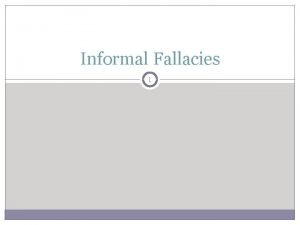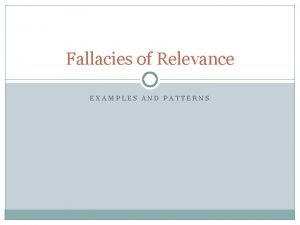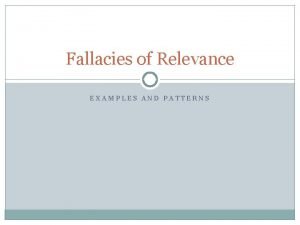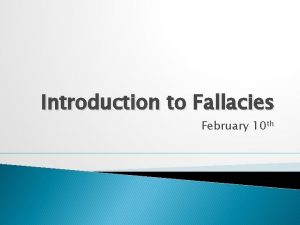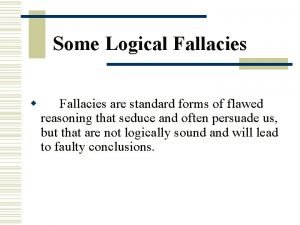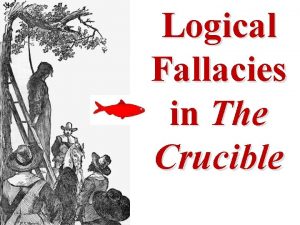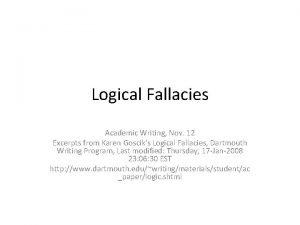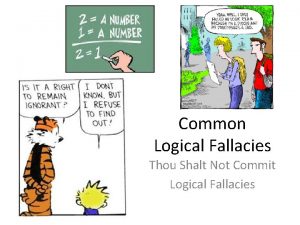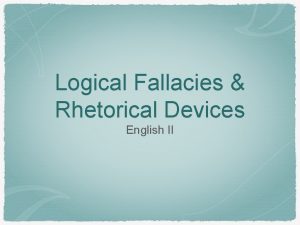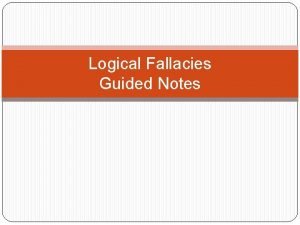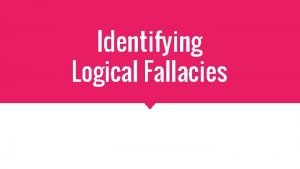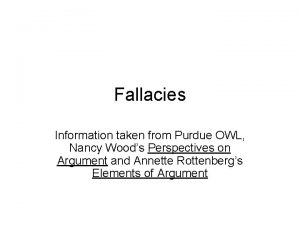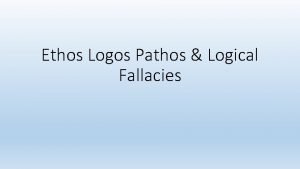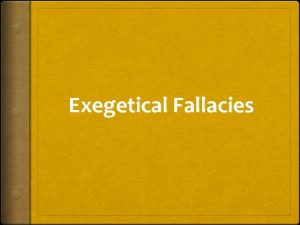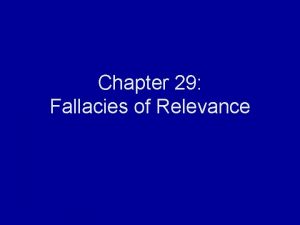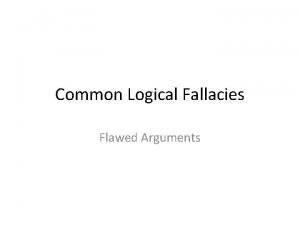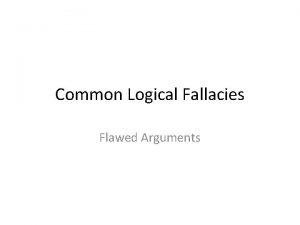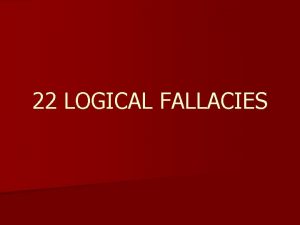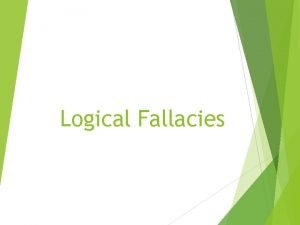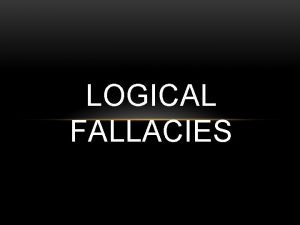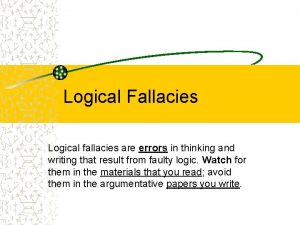Chapter 5 Logical Fallacies I Fallacies of Relevance













- Slides: 13

Chapter 5 Logical Fallacies I Fallacies of Relevance http: //b 1105. wordpress. com

• Chapter 5: Logical Fallacies--1 • Assessing Relevance • Determine whether the premises in the following arguments are positively relevant, negatively relevant, or irrelevant to the conclusion. • 1. Felix is a parrot. So Felix has feathers. • 2. Halle is fifteen-years-old. So, Halle is a senior in high school. • 3. Figure X is a triangle. So, figure X is a square.

• Chapter 5: Logical Fallacies--1 • Assessing Relevance • Determine whether the premises in the following arguments are positively relevant, negatively relevant, or irrelevant to the conclusion. • 1. Felix is a parrot. So Felix has feathers. • 2. Halle is fifteen-years-old. So, Halle is a senior in high school. • 3. Figure X is a triangle. So, figure X is a square. • 1. positively relevant • 2. negatively relevant • 3. negatively relevant

• Indicate in the space provide whether the following statements are true (T) of false (F). • ______ 1. A fallacy is an argument that contains at least one false premise. • ______ 2. Fallacies of relevance are fallacies that occur because the premises, though logically relevant to the conclusion, fail to provide sufficient evidence for the conclusion. • ______ 3. A statement is positively relevant to another statement if it counts in favor of that statement.

• Indicate in the space provide whether the following statements are true (T) of false (F). • ______ 1. A fallacy is an argument that contains at least one false premise. • ______ 2. Fallacies of relevance are fallacies that occur because the premises, though logically relevant to the conclusion, fail to provide sufficient evidence for the conclusion. • ______ 3. A statement is positively relevant to another statement if it counts in favor of that statement. • 1. F • 2. F • 3. T

• Identifying Fallacies • Identify the fallacies of relevance committed in the following passages. If no fallacy is committed, write "no fallacy. " • 1. Gambling is wrong, because it's wrong to play at games of chance for stakes. • 2. It would be a mistake to appoint Pete Dobson as Superintendent of Schools. Mr. Dobson has twice been convicted of child endangerment and he was recently charged with embezzlement. • 3. In a recent issue of Stogey magazine, Julio Fumar argues that Honduran cigars are better than Cuban cigars. But Fumar's argument isn't worth the paper it's printed on. Fumar is biased against Cuba because the Castro regime imprisoned his parents.

• Identifying Fallacies • Identify the fallacies of relevance committed in the following passages. If no fallacy is committed, write "no fallacy. " • 1. Gambling is wrong, because it's wrong to play at games of chance for stakes. • 2. It would be a mistake to appoint Pete Dobson as Superintendent of Schools. Mr. Dobson has twice been convicted of child endangerment and he was recently charged with embezzlement. • 3. In a recent issue of Stogey magazine, Julio Fumar argues that Honduran cigars are better than Cuban cigars. But Fumar's argument isn't worth the paper it's printed on. Fumar is biased against Cuba because the Castro regime imprisoned his parents. • 1. begging the question • 2. no fallacy • 3. attacking the motive

• Chapter 6: Logical Fallacies--2 • True/False • Indicate in the space provided whether the following statements are true (T) of false (F). • ______ 1. Critical thinkers never accept a claim on the mere say-so of another. • ______ 2. If a person accepts a claim on the sayso of an alleged witness or authority, and there is good reason to believe that the alleged witness or authority is biased, then the person commits the fallacy of inappropriate appeal to authority.

• True/False • Indicate in the space provided whether the following statements are true (T) of false (F). • ______ 1. Critical thinkers never accept a claim on the mere say-so of another. • ______ 2. If a person accepts a claim on the sayso of an alleged witness or authority, and there is good reason to believe that the alleged witness or authority is biased, then the person commits the fallacy of inappropriate appeal to authority. • 1. F • 2. T

• ______ 4. Some claims are so inherently controversial that they cannot be settled by appeals to expert opinion. • ______ 5. The following argument commits the fallacy of appeal to ignorance: "No one has ever seen Billie Jenkins ride his bike to school. So, probably Billy Jenkins rarely if ever rides his bike to school. " • ______ 6. The fallacy of false alternatives need not be explicitly expressed in "either…or" form.

• ______ 4. Some claims are so inherently controversial that they cannot be settled by appeals to expert opinion. • ______ 5. The following argument commits the fallacy of appeal to ignorance: "No one has ever seen Billie Jenkins ride his bike to school. So, probably Billy Jenkins rarely if ever rides his bike to school. " • ______ 6. The fallacy of false alternatives need not be explicitly expressed in "either…or" form. • 4. T • 5. F • 6. T

• Identifying Fallacies • Identify the fallacies of insufficient evidence committed in the following passages. If no fallacy is committed, write "no fallacy. " • 1. Giving half your money to charity is either morally obligatory or morally prohibited. But giving half your money to charity is not morally prohibited. In fact, it would be highly praiseworthy. Therefore, giving half your money to charity is morally obligatory. • 2. IRS agent: Mr. Peckinsniff, there is nothing in these documents that proves that you haven't been cheating on your taxes. Therefore, I must assume that you have been cheating on your taxes. • 3. Kids play too many video games. That's why there's so much juvenile crime today.

• Identifying Fallacies • Identify the fallacies of insufficient evidence committed in the following passages. If no fallacy is committed, write "no fallacy. " • 1. Giving half your money to charity is either morally obligatory or morally prohibited. But giving half your money to charity is not morally prohibited. In fact, it would be highly praiseworthy. Therefore, giving half your money to charity is morally obligatory. • 2. IRS agent: Mr. Peckinsniff, there is nothing in these documents that proves that you haven't been cheating on your taxes. Therefore, I must assume that you have been cheating on your taxes. • 3. Kids play too many video games. That's why there's so much juvenile crime today. • 1. false alternatives • 2. appeal to ignorance • 3. questionable cause
 Difference between formal and informal fallacy
Difference between formal and informal fallacy Example of attacking the motive fallacy
Example of attacking the motive fallacy Fallacies of relevance examples
Fallacies of relevance examples Fallacy of relevance
Fallacy of relevance Unqualified generalization
Unqualified generalization Fallacies in the crucible
Fallacies in the crucible Logical fallacies in academic writing
Logical fallacies in academic writing Thou shalt not commit logical fallacies image
Thou shalt not commit logical fallacies image Are logical fallacies rhetorical devices
Are logical fallacies rhetorical devices Logical fallacies guided notes
Logical fallacies guided notes Logical fallacy referee
Logical fallacy referee Love is a fallacy logical fallacies
Love is a fallacy logical fallacies Owl logical fallacies
Owl logical fallacies Pathos ethos logos quiz
Pathos ethos logos quiz
